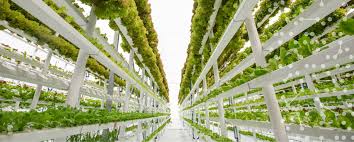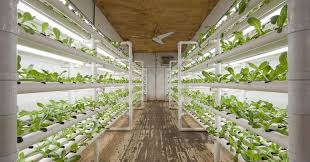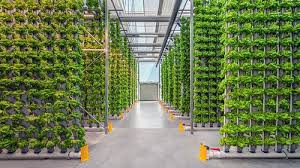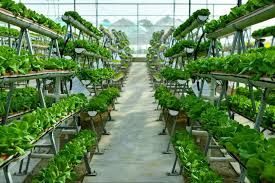Vertical farming is an innovative agricultural practice that involves growing crops in vertically stacked layers or on vertically inclined surfaces. This method is designed to optimize space, especially in urban areas where land is limited.
By using advanced technologies such as controlled environment agriculture (CEA), vertical farming allows for year-round production of fresh produce, regardless of external weather conditions.
This article explores the benefits of vertical farming, the different types of systems, and specific methods such as hydroponics, aeroponics, and aquaponics.
Benefits of Vertical Farming
Vertical farming offers numerous advantages that make it an attractive alternative to traditional agriculture:
1. Space Efficiency: Vertical farming maximizes land use by stacking crops vertically, making it ideal for urban settings where space is scarce.
2. Reduced Water Usage: Vertical farming uses up to 90% less water than conventional farming methods due to recirculation systems that reuse water.
3. Year-Round Crop Production: Controlled environments allow for continuous crop growth throughout the year, providing a steady supply of fresh produce.
4. Reduced Transportation Costs: By growing food closer to urban centers, vertical farms can reduce transportation time and costs, minimizing carbon emissions.
5. Pest and Disease Control: Indoor farming reduces exposure to pests and diseases, leading to less reliance on pesticides and herbicides.
6. Improved Crop Yields: The optimized growing conditions in vertical farms often result in higher yields compared to traditional farming methods.
Types of Vertical Farming Systems

Vertical farming systems can be categorized based on the growing techniques used. Here are three prominent types:
Hydroponic Systems
Hydroponics is a method of growing plants without soil, using nutrient-rich water instead. The key features of hydroponic systems include:
1. Nutrient Delivery: Plants receive essential nutrients directly through the water, promoting faster growth.
2. Space Efficiency: Hydroponic systems can be designed to maximize vertical space, often using shelves or towers.
3. Reduced Risk of Soil-borne Diseases: Without soil, the risk of diseases commonly associated with soil is minimized.
4. Faster Growth Rates: Many plants grow more quickly in hydroponic systems due to improved nutrient availability.
Aeroponic Systems
Aeroponics is a soilless growing technique that involves suspending plants in the air and misting their roots with a nutrient solution. Key aspects include:
1. Oxygenation of Roots: By allowing roots to be exposed to air, aeroponic systems promote greater oxygen absorption, leading to healthy growth.
2. Water Efficiency: Aeroponics uses even less water than hydroponics, as the misting process minimizes evaporation.
3. Space and Resource Efficiency: Aeroponic systems are compact and can be set up in small spaces, making them suitable for urban environments.
4. Faster Growth Rates: The optimal conditions for nutrient absorption can lead to rapid growth and higher yields.
Aquaponic Systems
Aquaponics combines aquaculture (raising fish) with hydroponics, creating a symbiotic environment where fish waste provides nutrients for plants. Important features include:
1. Sustainable Ecosystem: The waste produced by fish serves as a natural fertilizer for plants, while plants help filter and purify the water for fish.
2. Diverse Crop Production: Aquaponics allows for the cultivation of both fish and plants, creating a diversified food source.
3. Reduced Environmental Impact: This method promotes sustainability by minimizing water usage and eliminating the need for chemical fertilizers.
4. Enhanced Nutrient Content: The fish waste provides essential nutrients for plant growth, potentially leading to more nutritious produce.
Soil-Based Vertical Farming
Soil-based vertical farming involves growing crops in stacked layers of soil, integrating traditional soil cultivation methods with vertical farming techniques. Key points include:
1. Nutrient-Rich Soil: Soil-based systems provide natural nutrients and beneficial microorganisms to support plant health.
2. Water Retention: Soil can retain moisture more effectively than hydroponic systems, reducing the need for frequent watering.
3. Biodiversity: Soil-based systems may encourage a diverse ecosystem of beneficial organisms that contribute to soil health.
4. Traditional Growing Methods: These systems can be more familiar to conventional farmers, making the transition easier.
Stackable Systems
Stackable systems are modular farming units that allow growers to expand their production capacity vertically. Important features include:
1. Flexibility: Stackable units can be added or removed based on space and production needs.
2. Space Optimization: These systems maximize vertical space, making them suitable for urban farming.
3. Easy Maintenance: Individual units can be accessed easily for planting, maintenance, and harvesting.
4. Customization: Growers can choose the size and layout of stackable systems to suit their crop types.
Read Also: 18 Medicinal Health Benefits Of Rauvolfia verticillata (Devil Pepper)
Container Farms

Container farms utilize repurposed shipping containers to create fully functional vertical farms. Key characteristics include:
1. Mobility: Container farms can be relocated easily, allowing farmers to optimize space and access markets.
2. Controlled Environment: These units can be equipped with climate control technologies to create optimal growing conditions.
3. Cost-Effective: Container farms can be more affordable to set up than large-scale indoor farms.
4. Versatile Production: Growers can cultivate a variety of crops, from leafy greens to herbs, in container farms.
Controlled Environment Agriculture (CEA)
Controlled environment agriculture refers to any growing practice that optimizes environmental conditions for plant growth. Key aspects include:
1. Climate Control: CEA systems allow for precise control of temperature, humidity, and light levels.
2. Year-Round Production: By creating optimal conditions, CEA systems can produce crops regardless of seasonal changes.
3. Resource Efficiency: CEA can minimize water and energy use while maximizing crop yields.
4. Advanced Technologies: CEA often incorporates technologies such as sensors, automation, and data analytics for improved efficiency.
Read Also: 18 Medicinal Health Benefits Of Iris scariosa (Alpine Iris)
Comparing Vertical Farming Systems

When comparing different vertical farming systems, consider the following factors:
1. Resource Use: Assess water and energy consumption for each system.
2. Crop Types: Different systems may be better suited for specific crops.
3. Space Requirements: Evaluate the spatial efficiency and layout of each system.
4. Initial Investment: Analyze the costs associated with setting up and maintaining each system.
5. Yield Potential: Compare the expected crop yields based on the growing methods used.
Vertical farming represents a revolutionary approach to agriculture, offering sustainable solutions to food production challenges in urban environments.
By utilizing hydroponics, aeroponics, aquaponics, soil-based systems, stackable systems, container farms, and controlled environment agriculture, farmers can maximize space, reduce resource consumption, and produce high-quality crops year-round.
As technology continues to advance, vertical farming holds great promise for the future of agriculture, addressing food security and environmental concerns.
Do you have any questions, suggestions, or contributions? If so, please feel free to use the comment box below to share your thoughts. We also encourage you to kindly share this information with others who might benefit from it. Since we can’t reach everyone at once, we truly appreciate your help in spreading the word. Thank you so much for your support and for sharing!
Read Also: The Ultimate Guide to Unlocking the Potential of Garbage Wastes






